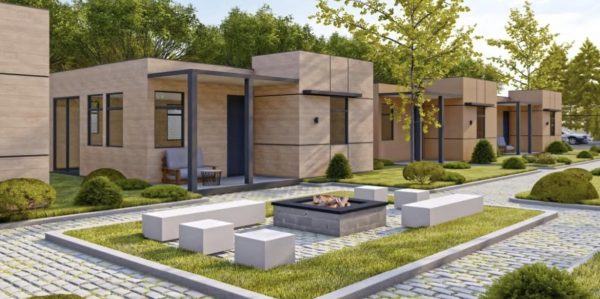The city of Evanston, a town known for its old and beautiful homes, recently approved a new project in the Seventh Ward: a housing complex on Grant Street. The proposal was met with much controversy from neighboring residents, but in the end, the decision was made to begin construction, albeit with some requirements.
The housing complex was first proposed in August 2023 by David Wallach, CEO of the Wisconsin-based Bluepaint Development. It is set to be built two blocks west of Kingsley Elementary school, and will include 12 two-bedroom houses selling for just under $350,000 each. The original plan has undergone multiple changes after feedback from residents and City staff.
“It’s a double lot, 100 feet wide and 290 feet long, so it’s a really odd lot. They’re all two bedrooms, and they were originally designed as a kind of one and a half bedroom, like a convertible bedroom unit. [The City] told us that their biggest need is a legitimate two bedroom, so we changed that,” said Wallach. “We have a lot of green space around it and a great gathering area in the back with a barbecue [area], and it’ll have 15 parking spaces on site.”

The purpose of this new complex is not exactly sustainability. As opposed to what many believe about the development, its primary goal is not to be especially eco-friendly or affordable, but instead to combat a lack of middle (medium-density) housing in Evanston.
“The reality is that they’re just homes. I don’t think they need any great adjectives to describe them,” said Wallach.
On Feb. 12, the Planning and Development Committee advanced the proposal and voted for an amendment to the exact zoning text, but in light of conflict between the developers and Seventh Ward residents, the City Council sent the plan back to the Committee on Feb. 26. On Feb. 26, the Council voted 8-0 to delay the final decision even further, as a spot in the March 11 City Council meeting, before the eventual 7-2 approval of the project, was reserved for residents to share their thoughts on the then-proposed neighborhood.
Residents took advantage of the opportunity, mainly voicing their desire to see the proposal undergo further scrutiny, similar to the recent Ryan Field approval process.
“We’re asking you to vote to return this proposal to the planned development process, so that we can all get the information we need and you can do your due diligence,” said resident Cindy Bebee, speaker for a group of neighbors in opposition to the proposal.
Prior to the March 11 meeting, the backlash from neighboring residents had gotten to the point where a petition was signed; over 100 signatures protested the development of the neighborhood.
“If built, it will increase density, noise, parking problems, traffic congestion and decrease property values. In addition, we believe that this development does not meet the requirement that it will ensure buildings will ‘maintain appealing character of Evanston neighborhoods while guiding their change,’ or ‘address concerns about housing cost and affordability,’ as noted in the application,” read the petition.
However, Wallach believes quite strongly that there wasn’t enough research done before opposing the proposal. He argued that the true purpose of the development is not truly understood, and urged residents to seek out all information.
“If you read the petition, [it says] they’re going to bring down [housing] values because it’s an affordable product. It’s going to create more noise. No, it’s not. It’s going to create more traffic. No, it’s not. It’s going to be lower quality housing. No, it’s not,” said Wallach.
Throughout the debate process in Evanston, Wallach noticed a significant discrepancy between his vision for the project and what opposed residents were saying.
“A couple weeks ago, we were in front of Planning and Development, and a number of people stood up and spoke against the project. And I remember sitting next to a person and I looked at her and said, ‘What project are they talking about?’ It’s such a mismatch of what we’re doing, what we’re delivering, and what our intent is,” said Wallach. “It’s sad that none of them have ever reached out to call us and talk to us.”
The real purpose of the complex, according to Wallach, is to address the local and national issue of middle housing supply.
“I think that there’s a national concern for missing middle housing. You know, everybody needs to kind of clean up their own room, right? Evanston is faced with the same type of problems, and all places are, so it’s a microcosm of a national issue,” said Wallach.
This neighborhood is Wallach’s vision for a better Evanston.
“This is our way of helping solve that problem,” Wallach said. “It takes a small dent, but you have to start somewhere.”







